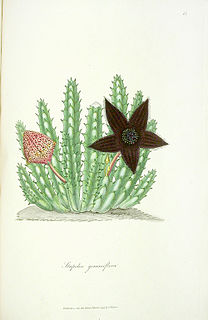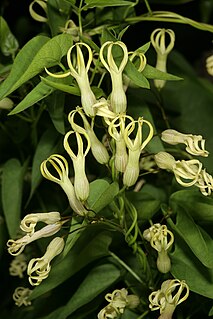
Duvalia is a succulent plant genus in the subfamily Asclepiadoideae, in the family Apocynaceae (dogbane).

Eleocharis is a virtually cosmopolitan genus of 250 or more species of flowering plants in the sedge family, Cyperaceae. The name is derived from the Greek words ἕλειος (heleios), meaning "marsh dweller," and χάρις (charis), meaning "grace." Members of the genus are known commonly as spikerushes or spikesedges. The genus has a geographically cosmopolitan distribution, with centers of diversity in the Amazon Rainforest and adjacent eastern slopes of the South American Andes, northern Australia, eastern North America, California, Southern Africa, and subtropical Asia. The vast majority of Eleocharis species grow in aquatic or mesic habitats from sea level to higher than 5,000 meters in elevation.

Bulbine is a genus of plants in the family Asphodelaceae and subfamily Asphodeloideae, named for the bulb-shaped tuber of many species. It was formerly placed in the Liliaceae. It is found chiefly in Southern Africa, with a few species extending into tropical Africa and a few others in Australia and Yemen.

Tridentea is a genus of succulent plant in the family Apocynaceae, endemic to southern Africa.

Dysphania is a plant genus in the family Amaranthaceae, distributed worldwide from the tropics and subtropics to warm-temperate regions.
Woodia is a genus in the family Apocynaceae first described as a genus in 1894. It is native to southern Africa
- Woodia mucronataN.E.Br.
- Woodia singularisN.E. Br.
- Woodia verruculosaSchltr.
Tenaris is a genus of plant in family Apocynaceae, first described as a genus in 1838. It is native to southern Africa.
- Tenaris brownianaS. Moore - Angola
- Tenaris chloranthaSchltr. - South Africa
- Tenaris filifolia(Schltr.) N.E. Br. - South Africa
- Tenaris schultzei(Schltr.) E. Phillips - Kalahari Desert
- Tenaris rubella, syn of Brachystelma rubellum
- Tenaris simulans, syn of Brachystelma rubellum
- Tenaris subaphylla, syn of Caralluma edulis

Telosma is a genus of plants in the family Apocynaceae, first described in 1905. It is native to Africa, and Asia.
Orbeopsis is a genus of plants in the Apocynaceae, first described as a genus in 1978. They are native to southern Africa.
- Orbeopsis albocastanea(Marloth) L.C. Leach - Great Namaqualand in Namibia
- Orbeopsis gerstneri(Letty) L.C. Leach - KwaZulu-Natal
- Orbeopsis knobelii(Phillips) L.C. Leach - Botswana
- Orbeopsis melanantha(Schltr.) L.C. Leach - South Africa
- Orbeopsis valida(N.E. Br.) L.C. Leach - Zimbabwe

Piaranthus is a succulent plant genus in the subfamily Asclepiadoideae, in the family Apocynaceae.
Huerniopsis is a genus of plants in the Apocynaceae family, first described in 1878. It is native to southern Africa.
- Huerniopsis atrosanguinea(N.E. Br.) A.C. White & B. Sloane - N Botswana
- Huerniopsis decipiensN.E.Br. - Western Cape Province
- Huerniopsis gibbosaNel - Lobatsi in Botswana
- Huerniopsis papillataNel - Debeeti in Botswana

Orbea is a genus of flowering plants of the family Apocynaceae, first described as a genus in 1812. It is native to Africa.
Anisotoma is a genus of flowering plants formerly belonging to the plant family Asclepiadaceae, now considered to be part of the Apocynaceae, first described as a genus in 1844. They are native to South Africa
- Anisotoma cordifoliaFenzl - South Africa
- Anisotoma pedunculataN.E.Br. - KwaZulu-Natal

Pachycarpus is a genus of plants in the family Apocynaceae, first described in 1838. It is native to Africa.

Riocreuxia is a plant genus in the family Apocynaceae, and named in honour of the botanical illustrator Alfred Riocreux (1820-1912). It was first described as a genus in 1844 and is native to Africa.
Parapodium is a genus of flowering plants of the family Apocynaceae, first described as a genus in 1838. It is native to South Africa.
- Parapodium costatumE.Mey. - South Africa
- Parapodium crispumN.E.Br. - South Africa
- Parapodium simileN.E.Br. - South Africa
Pectinaria is a genus of plants in the family Apocynaceae, first described as a genus in 1819. The entire genus is endemic to South Africa.

Pentarrhinum is a genus of plants in the family Apocynaceae, first described as a genus in 1838. It is native to Africa.
- Pentarrhinum abyssinicumDecne. - E + C + S Africa
- Pentarrhinum balense(Liede) Liede - Ethiopia
- Pentarrhinum coriaceumSchltr. - KwaZulu-Natal
- Pentarrhinum gonoloboides(Schltr.) Liede - Tanzania
- Pentarrhinum insipidumE.Mey. - South Africa
- Pentarrhinum ledermannii(Schltr.) Goyder & Liede - Burundi
- Pentarrhinum somaliense(N.E. Br.) Liede - Somalia
Pentatropis is a genus of plants in the family Apocynaceae, first described as a genus in 1834. It is native to Africa and southern Asia.

Sisyranthus is a group of plants in the family Apocynaceae first described as a genus in 1838. It is native to southern Africa.











